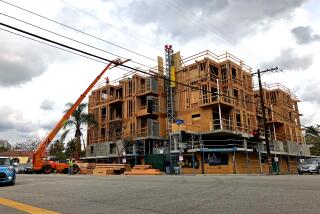Council Wary of Wetlands Protection Law : Thousand Oaks: Officials send the draft ordinance on to planners. Some worry about red tape and the effects on building.
- Share via
A majority of Thousand Oaks City Council members have expressed misgivings about a draft wetlands protection law, noting that its strict provisions could block construction of major shopping malls and back-yard decks alike.
But by a 3-2 vote, the council agreed to move ahead with the ordinance by referring it to the Planning Commission for review and public hearing.
“This city stands on our commitment to create a sustainable community that values natural resources,” said Mayor Elois Zeanah, who led the drive for a wetlands protection ordinance.
As proposed, the law would ban all construction within 50 feet of streams, ponds or even seasonally swampy soil. If the wetland were deemed especially sensitive, the buffer zone could be extended to 100 feet.
But since the California Department of Fish and Game and the U.S. Army Corps of Engineers already monitor wetlands, some council members worried that the Thousand Oaks law would contribute only a tangle of red tape.
“What do we gain from this ordinance?” Councilwoman Judy Lazar asked. “Are we just instituting another layer of bureaucracy?”
Both the state and federal agencies encourage buffer zones. Yet they permit development near waterways if the habitat is considered degraded or relatively insignificant. The Thousand Oaks law, in contrast, would mandate a minimum 50-foot buffer zone around any area that is “periodically, seasonally or continuously submerged, or which has high soil moisture.”
In a heated hourlong discussion on Tuesday, three developers testified against the draft ordinance. Some complained that the law could block their constitutional right to build on their property; others protested that it would create unnecessary bureaucracy.
Providing the most strident opposition to the law, Councilman Alex Fiore challenged city staff to list “any wetlands of any significance in Thousand Oaks that has been eliminated because of development.”
City planner Greg Smith cited a few examples of lost habitat along the Arroyo Conejo and on the Shapell housing tract in Newbury Park.
But Fiore insisted that the city had done an admirable job of protecting wetlands--even without an ordinance. And he predicted that a new law would kick off a flurry of overzealous environmental activism at the expense of development.
“In two or three years, there will be another ordinance saying we’ve got to protect the buffer zone, so we’ll have to set aside a 50-foot buffer around the first buffer,” Fiore said. “We can go on and on and on.”
But on Wednesday, biologist Ken Wilson of the state Department of Fish and Game endorsed the concept of a buffer zone. Deer, rabbits, bobcats and other animals need waterways for survival, he said, and have trouble gaining access when development marches right up to creek banks.
“Streams are lost because people tend to crowd them,” Wilson said. “A minimal buffer zone would be very desirable from an environmental standpoint.”
The Planning Commission will hold a public hearing on the draft law within the next few months, after city staff identifies which parcels in Thousand Oaks would be affected by the buffer-zone rule. The commission will recommend changes and then pass the draft back to the City Council for further debate. A final vote will take place no earlier than February.
Already, however, some developers are furious.
Developer Albert Cohen showed up at Tuesday’s meeting with a poster showing that 65% of his Newbury Park property would fall within a protected area if the city enforced a 50-foot buffer zone around the riparian habitat.
In the decade that he has been trying to obtain city permission to develop his 47-acre lot, Cohen said, the wetland zone has tripled to about nine acres. The marshy area has spread because it lies in a flood plain with inadequate drainage.
“If you set back 50 feet on both sides of both creeks on the commercial (zoned) part of my property, we have nothing left to develop,” Cohen said. “Pass this ordinance and we’ll be in court for another 20 years.”
The draft law does allow for some flexibility: Property owners could get permission to build near wetlands if their parcel’s size or topography made it impossible to maintain a 50-foot buffer.
But developers allowed to encroach into wetlands would have to refrain from cutting or disturbing the riparian brush between April 1 and Sept. 1--leaving little time for construction before the rainy season.
More to Read
Sign up for Essential California
The most important California stories and recommendations in your inbox every morning.
You may occasionally receive promotional content from the Los Angeles Times.










